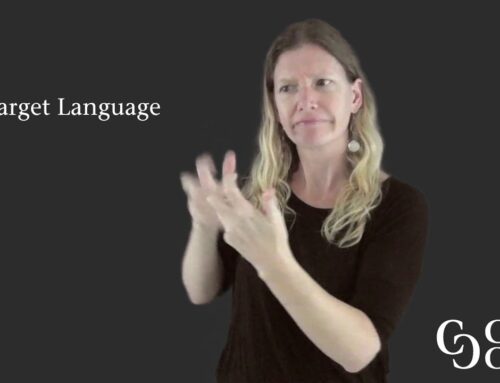Aim
To conduct a stimulated recall to identify what you were thinking during the interpretation process.
Time Required for Activity: 15-30 mins
Objective(s):
Interpreters will:
- Conduct a Think Aloud Protocol and record their thoughts.
- Review their thoughts and identify patterns.
You can use this activity to address a variety of skills, including preparing for interpreting assignments, identifying specific skills needed for different situations, and managing emotions during interpreted situations.
Reference
Russell, D. & Winston, B. (2014). TAPing into the interpreting process: Using participant reports to inform the interpreting process. The International Journal for Translation & Interpreting Research, 6(1).
Smith, A. (2014). Think aloud protocols: viable for teaching, learning, and professional development in interpreting. The International Journal for Translation & Interpreting Research, 6(1).
Defining a Stimulated Recall
A Stimulated Recall (SR) is a form of Think Aloud Protocol (TAP) that allows you to express anything and everything that is going through your mind while you review your interpretation. An SR can be done in at least two ways:
- Try to recall what you were thinking while you were interpreting. This can help give more insight into your decision-making process during the actual interpretation. To do this, it can be helpful to start with this phrase in mind: “At the time, I was thinking….“
- You can share whatever you are thinking while reviewing your interpretation. This is much more free flowing – and you can share whatever your thoughts are at the time of reviewing your interpretation.
These thoughts might span various stages of the process:
- audience/context,
- comprehension,
- analysis,
- assigning meaning,
- source/target representation,
- letting go of form,
- composition,
- any of the setting factors that may impact the interpretation, etc.
Feel free to just let your thoughts run free without the worry of producing complete sentences.
Formats for Stimulated Recall
- To capture your thoughts in the most natural form, it is best to record your stimulated recall using GoReact or your phone or a webcam. Use your native language.
- As an adaptation, you can also type out written comments connected to the time code in the video. This will make it easier to share your thoughts; however, it does not allow your SR to be as free flowing.
Example of a Stimulated Recall
Here is an example of a stimulated recall done in GoReact by Doug Bowen-Bailey, one of the CATIE Center’s instructional designers. He uses written comments and includes the optional codes for which category each comment fits within – explained later.

Here is a video of the Stimulated Recall – edited to show the comments more clearly.
Please note: Doug is hearing interpreter who has been certified for over 25 years – so some of his comments may be different than that of a novice interpreter.
Step One: Select Your Source
You can choose a source video from the GTC Resource Library – or you can select a source from your life. Though it would be more complicated, you could even record an authentic interpretation (as long as you have appropriate permissions) and then use that for your stimulated recall.
Depending on how long your source is, it will lengthen the time needed for this activity.
Finding the URL of your Source
If you are using GoReact, copy the URL of the YouTube video. You can click on the “Share” arrow in the upper right of the video window and then copy the URL that is displayed. You will then be able to add this as a stimulus in GoReact to work from.


Step Two: Watch Source and Record Your Thinking
Watch your interpretation and record what it is you were thinking during your interpretation. Here are some questions you can use to help prompt your thinking:
- What do you notice about the person (or people) who are included in the source? (This includes both speaker(s) and audience.)
- What were decision points for you during the interpreting process?
- Do you have any thoughts or questions about the language used?
- What do you notice about the context?
- What emotions are you experiencing as you were interpreting?
Recording Your SR Comments
Here are the options for recording your thinking:
- If using sign language, set your phone or another recording device to record your thinking as you view the interpretation.
- If you are using spoken language, you can record with your phone or another recording device.
- If you want to use written language, you can type out your thoughts. (This might require you to pause the video while you share your thoughts.)
- If you have access to GoReact, you can add your source to GoReact as a stimulus and then watch the video and record your thoughts directly in GoReact. (If you are interested in getting access to GoReact, it is available through the GTC Journey Track.)
- If you do not have access to GoReact, you can make a copy of this Google Sheet and document the time code and your comments.
Step Three: Look for Patterns in Your Thoughts
Review your documentation of your thinking. Reflect on the following questions:
- What patterns do you notice in your thinking about your interpretation?
- Do you notice any connection between how you are feeling and certain events in the source?
- What extralinguistic knowledge do you need to better prepare you for understanding the source text?
Optional Coding of Comments
Russell and Winston (2014) identified categories of stimulated recall comments.
- Presenter Intent
- Audience Needs
- Interpreting Process
- Linguistic Issues
Their research shows that novice interpreters tend to focus on linguistic issues and interpreting process while more experienced interpreters focus more on presenter intent and audience needs. So, this can be a way to evaluate how your thought process related to interpreting develops over time.
Step Four: Engage in Dialogue with Partner (Optional)
If you have a mentor, coach, or peer who you are working with, you can use dialogue to deepen your learning.
One possibility is for both of you to interpret the same source, and then compare your SRs or you can simply share your SR with your partner and see if they have questions or notice anything in the thoughts you have identified.
Getting Started
Getting Started
To begin, click on the Step 1 toggle.





